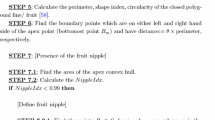Abstract
The “Protection of Plant Varieties and Farmers' Rights Act. (PPBFRA)” recognizes and protects the rights for the development of new plant varieties for a set duration. Only if a variety satisfies the requirements of distinctness, uniformity, and stability (DUS), can be registered and preserved. It means the new variety's characteristics must be distinct, uniform, and stable. The DUS protocol's test recommendations are a collection of characteristics determined by the national authority. The major part of these recommendations is the measurement of the morphological and color-based characteristics of different plant parts. Manually measuring these characteristics in the field is subjective and vulnerable to human error. The derivation of DUS-defined physiological and color characteristics of Okra stem, flower, and seed are proposed in this article using machine vision technology. To capture pictures of Okra stem, flower, and seed after harvesting from the field, a dark room imaging system was built utilizing a DSLR camera. The same setup was used to acquire all of the pictures following the designed protocol for each plant part. To obtain the necessary morphological and color-based DUS features, digital image processing and analysis methods were used. With fewer human interventions in comparison with conventional techniques, the proposed methodology precisely provides the DUS-defined features. The accuracy of the methodology, when compared to manual measurement, justifies its applicability for objectively assessing the DUS-defined features.
Access this chapter
Tax calculation will be finalised at checkout
Purchases are for personal use only
Similar content being viewed by others
References
Protection of plant varieties and farmers’ rights authority, India.http://www.plantauthority.in/. Accessed on 27 Apr 2020
Training Manual on DUS Test in Cotton with reference to PPV & FR legislation, 2001, 19th to 25th January, 2005
Crop DUS Guidelines. https://www.plantauthority.gov.in/crop-dus-guidelines, Accessed on: second September 2021.
Jyoti B, Usha PS (2015, December) Role of DUS testing in registration of plant varieties under PPVV & FR Act, 2001. Rashtriya Krishi 10(2). e ISSN–2321–7987
Guidelines for the conduct of test for Distinctiveness, Uniformity, and stability on Okra/Lady’s Finger (Abelmoschusesculentus (L.) Moench.): protection of plant varieties and Farmer’s rights authority, Government of India: SG/35/2009, November 3, 2009. https://www.plantauthority.gov.in/sites/default/files/fokra.pdf
Ranjan P (2009) Recent developments in India’s plant variety protection, seed regulation and linkages with UPOV’s proposed membership. J World Intellect Property 12(3):219–243. https://doi.org/10.1111/j.1747-1796.2009.00365.x
Yu J-K, Chung Y-S (2021) Plant variety protection: current practices and insights. Genes 12:1127. https://doi.org/10.3390/genes12081127.
Yang CJ, Russell J, Ramsay L et al (2021) Overcoming barriers to the registration of new plant varieties under the DUS system. Commun Biol 4:302. https://doi.org/10.1038/s42003-021-01840-9
Kotwaliwale N, Singh K, Chakrabarty SK, Joshi MA, Kalne A, Tiwari M, Gangopadhyay KK, Bhattacharya n, Akuli A, Aggarwal D, Bej G (2019) Machine vision for characterization of some phenomic features of plant parts in distinguishing varieties–a review. Int J Bio-Inspired Comput (IJBIC) 14(4). https://doi.org/10.1504/IJBIC.2019.103960
Bej G et al (2021) Comparison of different color models for priority based color matching of plant parts used in DUS testing. In: Balas VE. Hassanien AE, Chakrabarti S, Mandal L (eds) Proceedings of international conference on computational intelligence, data science and cloud computing. Lecture notes on data engineering and communications technologies, vol 62. Springer, Singapore. https://doi.org/10.1007/978-981-33-4968-1_37
Dhaliwal I et al (2020) DUS characterization of some released varieties and advanced breeding lines of Soybean (Glycine max L.) under Punjab agroclimatic conditions. Int J Curr Microbiol App Sci 9(8):2124–2135. https://doi.org/10.20546/ijcmas.2020.908.242
Palakshappa MG et al (2020) DUS testing of sesame (Sesamum indicum L.) Accessions using morphological descriptors and evaluation for foliar diseases of sesame. Int J Curr Microbiol App Sci 9(1):1837–1852. https://doi.org/10.20546/ijcmas.2020.901.206
Temam N, Mohammed W, Aklilu S (2021) Variability assessment of Okra (Abelmoschus esculentus (L.) Moench) genotypes based on their qualitative traits”, 2021 ,International Journal of Agronomy,DOI: https://doi.org/10.1155/2021/6678561
Matthew O, Ohwo Uo, Osawaru M (2018) Morphological characterization of Okra (Abelmoschus [Medik.]) accessions. Makara J Sci. 22. https://doi.org/10.7454/mss.v22i2.9126
Al-jabery KK, Obafemi-Ajayi T, Olbricht GR, Wunsch II DC, 9—data analysis and machine learning tools in MATLAB and Python. In: Al-jabery KK, Obafemi-Ajayi T, Olbricht FGR, Wunsch II DC (2020) Computational learning approaches to data analytics in biomedical applications. Academic Press, pp 231–290. ISBN 9780128144824, https://doi.org/10.1016/B978-0-12-814482-4.00009-7
Liu Y-f et al (2013) Statistic analysis on quantitative characteristics for developing the DUS test guideline of Ranunculus asiaticus L. J Integr Agric 12(6): 971-978. https://doi.org/10.1016/S2095-3119(13)60317-2
Manliguez C (2016) Generalized confusion matrix for multiple classes. https://doi.org/10.13140/RG.2.2.31150.51523
Santhy V, Rathinavel K, Saravanan M, Meshram C, Priyadharshini M (2020) Genetic diversity assessment of extant cotton varieties based on principal component analysis (PCA) and cluster analysis of enlisted DUS traits. Electron J Plant Breed 11(2):430–438. Retrieved from http://www.ejplantbreeding.org/index.php/EJPB/article/view/3386
Acknowledgements
This project was funded by the National Fund for Basic, Strategic and Frontier Application Research in Agriculture (NFBSFARA), Indian Council of Agricultural Research, New Delhi. The authors are grateful to the funding agency for providing support and guidance. The authors are also grateful to Dr. Nachiket Kotwaliwale (CIAE, Bhopal, India) and Dr. K.K. Gangopadhyay (NBPGR, New Delhi, India) for their constant support.
Author information
Authors and Affiliations
Corresponding author
Editor information
Editors and Affiliations
Rights and permissions
Copyright information
© 2022 The Author(s), under exclusive license to Springer Nature Singapore Pte Ltd.
About this paper
Cite this paper
Bej, G. et al. (2022). Extraction of Appearance-Based DUS Characteristics of Okra Stem, Flower, and Seed Using Image Processing. In: Mandal, L., Tavares, J.M.R.S., Balas, V.E. (eds) Proceedings of International Conference on Computational Intelligence, Data Science and Cloud Computing. Algorithms for Intelligent Systems. Springer, Singapore. https://doi.org/10.1007/978-981-19-1657-1_17
Download citation
DOI: https://doi.org/10.1007/978-981-19-1657-1_17
Published:
Publisher Name: Springer, Singapore
Print ISBN: 978-981-19-1656-4
Online ISBN: 978-981-19-1657-1
eBook Packages: Intelligent Technologies and RoboticsIntelligent Technologies and Robotics (R0)




